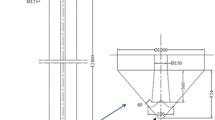Abstract
The understanding of the flow field inside the cold store is very important to food storage at low temperatures. In this paper, the CFD simulation on the flow field for low temperature cold store with air forced supply mode is presented. The turbulence flow of three-dimensional steady incompressible viscous fluid is analyzed using finite volume method and standard K-ε two-equation. The temperature and velocity fields of this cold store are simulated, analyzed and compared. The simulation results show that the velocity and temperature fields are evidently influenced by the cross section from the ground, and the optimal cross section is also given in this paper.



Similar content being viewed by others
Abbreviations
- ρ:
-
Fluid density (kg/m3)
- ϕ:
-
Variable item (such as velocity, temperature or concentration)
- t :
-
Time (s)
- v :
-
Velocity (m/s)
- x i :
-
Directions in the right-angle coordinate system
- Γ:
-
Pervasion coefficient
- p eff :
-
Pressure (Pa)
- u eff :
-
Dynamical viscosity (n.m/s2)
- u, v, w:
-
Different velocity in three dimension coordinate system (m/s)
- T :
-
Temperature (°C)
- P r :
-
Prandtl’s number
- q :
-
Inner heat source (W/m3)
- c p :
-
Specific heat (J/(kg.C))
- g :
-
Acceleration of gravity (m/s2)
- σ T :
-
Constant, its value is 0.9 ~ 1
- σ k :
-
Constant
References
Kondrashov VI, Tyukov VM (2006) Simulation of the heat-and-mass transfer in the mound of stored biological product with centers of spontaneous heating. Heat Mass Transfer 43:191–199
Smale NJ, Moureh J, Cortella G (2006) A review of numerical models of airflow in refrigerated food applications. Int J Refrigerat 29:911–930
Norton T, Sun DW (2006) Computational fluid dynamics (CFD)—an effective and efficient design and analysis tool for the food industry: a review. Trends Food Sci Technol 17:600–620
Hu Z, Sun DW (2001) Predicting local surface heat transfer coefficients by different turbulent k-ε models to simulate heat and moisture transfer during air-blast chilling. Int J Refrigerat 24:702–717
Xie J, Qu XH, Shi JY, Sun DW (2006) Effects of design parameters on flow and temperature fields of a cold store by CFD simulation. J Food Eng 77:355–363
Yang Z, Xu XL, Li XH (2007) Simulation and experiment on the unsteady 3D flow field of cool store. J Tianjing Univ Sci Technol 40:157–162
Hoang ML, Verboven P, De Baerdemaeker J, Nicolaï BM (2000) Analysis of the air flow in a cold store by means of computational fluid dynamics. Int J Refrigerat 23:127–140
Nahor HB, Hoang ML, Verboven P, Baelmans M et al (2005) CFD model of the airflow, heat and mass transfer in cool stores. Int J Refrigerat 28:368–380
Rouaud O, Haver M (2002) Computation of the air flow in a pilot scale clean room using k-ε turbulence models. Int J Refrigerat 25:351–361
Negrao Cezar OR (1998) Integration of computational fluid dynamics with building thermal and mass flow simulation. Energy Build 27:155–165
Author information
Authors and Affiliations
Corresponding author
Rights and permissions
About this article
Cite this article
Hao, X.H., Ju, Y.L. Simulation and analysis on the flow field of the low temperature mini-type cold store. Heat Mass Transfer 47, 771–775 (2011). https://doi.org/10.1007/s00231-011-0764-1
Received:
Accepted:
Published:
Issue Date:
DOI: https://doi.org/10.1007/s00231-011-0764-1




